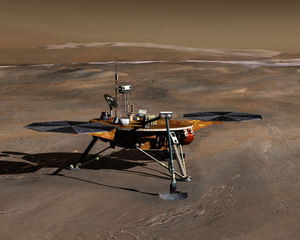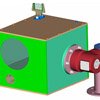Phoenix (spacecraft)
2007 Schools Wikipedia Selection. Related subjects: Space transport
The Phoenix is a planned multi-agency Mars lander, headed by the University of Arizona's Lunar and Planetary Laboratory, under the direction of NASA, scheduled to launch on August 3, 2007. It is a partnership of universities, NASA, the Canadian Space Agency, and the aerospace industry. Phoenix is scheduled to land in May 2008 in the planet's water-ice-rich northern polar region. It will dig its robotic arm into the arctic terrain searching for information on the history of water, and search for environments suitable for microbial life on Mars.
History
In August 2003 NASA selected the University of Arizona "Phoenix" mission for launch in 2007 as what is hoped will be the first in a new line of smaller, low-cost, " Scout" missions in the agency's exploration of Mars program. The selection was the result of an intense two-year competition with proposals from other institutions. The $325 million NASA award is more than six times larger than any other single research grant in University of Arizona history.
Dr. Peter H. Smith of the University of Arizona Lunar and Planetary Laboratory, was selected to lead the mission as Principal Investigator. The mission was named after the Phoenix, a mythological bird that is repeatedly reborn of ashes. Like the mythological bird, the 2007 Phoenix contains several previously built components. The lander used for the 2007 mission is the modified Mars Surveyor 2001 Lander (cancelled in 2000), along with several of the instruments from both that and the previous polar lander mission. Lockheed Martin had kept the nearly-complete lander in environmentally-controlled storage since 2001.
Phoenix is a partnership of universities, NASA centers, and the aerospace industry. The science instruments and operations will be a University of Arizona responsibility. NASA's Jet Propulsion Laboratory in Pasadena, California, will manage the project and provide mission design and control. Lockheed Martin Space Systems, Denver, Colorado, will build and test the spacecraft. The Canadian Space Agency will provide a meteorological station, including an innovative laser-based atmospheric sensor. The Co-Investigator institutions include Malin Space Science Systems, Max Planck Institute for Solar System Research, NASA Ames Research Centre, NASA Johnson Space Centre, Optech Incorporated, SETI Institute, Texas A&M University, Tufts University, University of Colorado, University of Michigan, University of Neuchâtel in Switzerland, University of Texas at Dallas, University of Washington, Washington University in St. Louis, and York University.
On June 2, 2005, following a critical review of the project's planning progress and preliminary design, NASA approved the mission to proceed as planned. The purpose of the review was to confirm NASA's confidence in the mission.
Mission
The mission has two goals. One is to study the geologic history of water, the key to unlocking the story of past climate change. The second is to search for evidence of a habitable zone that may exist in the ice-soil boundary, the "biological paydirt." The Phoenix's instruments are suitable for uncovering information on the geological and possibly biological history of the martian arctic. Because the Phoenix will be the first mission to return data from either of the poles, it will contribute to NASA's main strategy for Mars exploration, "Follow the water".
The spacecraft will be launched by a Boeing Delta 7925 vehicle, with the launch window starting August 3, 2007. After ten months in transit, Phoenix would land in May 2008 and begin a 90- sol primary mission—although it will likely continue to operate much longer.
Scientific payload
It will carry improved versions of University of Arizona panoramic cameras and volatiles-analysis instrument from the ill-fated Mars Polar Lander, as well as experiments that had been built for the Mars Surveyor 2001 Lander, including a JPL trench-digging robot arm and a chemistry-microscopy instrument. The science payload also includes a descent imager and a suite of meteorological instruments.
Robotic Arm (RA)

The Robotic Arm is designed to extend 2.35m from its base on the lander, and have the ability to trench up to half a meter below the surface. It will take samples of dirt and water-ice that will be analyzed with other instruments on the lander. The arm was designed and built for the Jet Propulsion Laboratory by Alliance Spacesystems, LLC in Pasadena California. Alliance has delivered both the engineering model and flight versions of the arm to JPL for testing and integration.
Robotic Arm Camera (RAC)

The Robotic Arm Camera will be attached to the Robotic Arm, just above the scoop. It will be a full-colour camera, which will be able to take pictures of the area, as well as verify the samples that the scoop will return, and will be able to examine the grains of the area where the Robotic Arm has just dug up. The camera is being made by the University of Arizona and Max Planck Institute, Germany.
Surface Stereo Imager (SSI)

The Surface Stereo Imager will be the primary camera on the spacecraft. It is a stereo camera that is described as "a higher resolution upgrade of the imager used for Mars Pathfinder and the Mars Polar Lander". It is expected to take many stereo images of the Martian Arctic. It will also be able, using the Sun as a reference, to measure the atmospheric distortion of the Martian atmosphere due to dust and air and other features. The camera is being provided by the University of Arizona in colaboration with the Max Planck Institute for Solar System Research.
Thermal and Evolved Gas Analyzer (TEGA)

TEGA is a combination of a high-temperature furnace with a mass spectrometer. It will be used to bake samples of Martian dust, and determine the content of this dust. It has 8 different ovens, each about the size of a large ball-point pen, which will be able to analyze one sample each, for a total of 8 different samples. Team members can measure how much water vapor and carbon dioxide gas are given off, how much water-ice the samples contain, and what minerals are present that may have formed during a wetter, warmer past climate. The instrument will also be capable of measuring any organic volatiles, up to 10 ppb. TEGA is being built by the University of Arizona and University of Texas at Dallas.
Mars Descent Imager (MARDI)

The Mars Descent Imager will be used to take pictures of the Martian soil as the lander descends. It will begin to take pictures after the aeroshell departs, about 5 miles above the Martian soil. These images will also help to pinpoint exactly where the lander has landed. It will be used to take pictures of the landing site, which will be used to find potential targets. It will also be used to learn if the area where the lander lands is typical of the surrounding terrain. It is being built by Malin Space Science Systems.
MARDI will be the lightest camera ever to land on Mars, as well as the most efficient. It only uses 3 watts of power during the imaging process, as compared to the many watts used by most other space cameras.
Microscopy, Electrochemistry, and Conductivity Analyzer (MECA)

MECA is a combination of a wet chemistry lab, optical and atomic force microscope, and a thermal and electrical conductivity probe. It is being built by the Jet Propulsion Laboratory,
Using this instrument, researchers will examine soil particles as small as 16 micrometres across. They will measure electrical and thermal conductivity of soil particles using a probe on the robotic arm scoop. One of the most interesting experiments is the wet chemistry laboratory.
The robotic arm will scoop up some soil, put it in one of four wet chemistry lab cells, where water will be added, and while stirring, an array of electrochemical sensors will measure a dozen dissolved ions such as sodium, magnesium, calcium, and sulfate in the water, that have leached out from the soil. This is important, because it will give us information as the biological compatibility of the soil, both for possible indigenous mirobes and for future Earth visitors. Sensors will also measure the pH and conductivity of the soil-water mixture, telling us if the wet soil is super acidic or alkaline and salty, or full of oxidants that can destroy life.
Meteorological Station (MET)
MET will record the daily weather during the course of the Phoenix Mission. It is equipped with a variety of temperature and pressure sensors to do so. It is also equipped with LIDAR, or Laser Imaging Detection and Ranging, which will be used to find the amount and number of dust particles in the air. It is being built by the Canadian Space Agency.
Engineering information
The Phoenix Lander is being built by Lockheed Martin. Most of its parts were built for the cancelled Mars Surveyor 2001 Lander. It was then locked away in a clean room for several years, until the mission was funded by the NASA scout program.
While many of the parts are being used from the previous spacecraft, many are being updated. The lander contains the following subsystems:
- A computer system for commanding the spacecraft and handling data
- An electrical system containing solar arrays and batteries
- A telecommunications system that can communicate directly with earth, as well as Mars Odyssey and the Mars Reconnaissance Orbiter
- A sophisticated guidance system to ensure the spacecraft will land successfully
- A propulsion system to land safely consisting of 6 hydrazine engines.
- The structure of the spacecraft
- Several mechanical systems to move parts of the spacecraft
- A sophisticated thermo-control system to ensure the spacecraft does not get too cold.

